What is the Correct Amount of Growing Room for Kids’ Shoes? – Find Out Now!
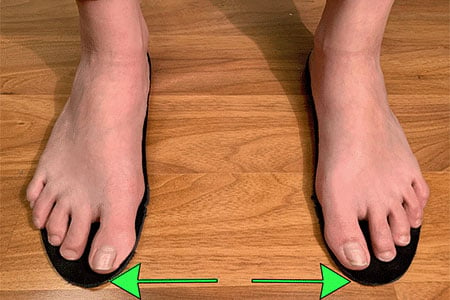
Providing your child with the correct amount of growing room is not only going to prevent your child from outgrowing the shoes faster than expected, but it is also going to keep your child’s feet healthy by preventing ordering shoes that are too big or too small. As a dedicated shoe fitter, I will show you how to check for growing room inside kids’ shoes, ensuring they fit just right.
How Much Room Should Kids Have in Their Shoes?
The ideal growing room in kids’ shoes is about 3/16 of an inch or 0.4 centimeters of space from the tip of the longest toe to the front of the shoe. I have tested those specific measurements in hundreds of kids and I can confidently tell you that is the correct amount of growing. This space allows for natural movement and growth without constricting the foot.
How to Check for the Correct Amount of Growing Room?
1. Your first step should be to remove the original insoles of the shoes.

2. The second step should be to have your child stand up in both insoles. Please remember that most people have half a size difference between their feet, hence the importance of checking both feet.
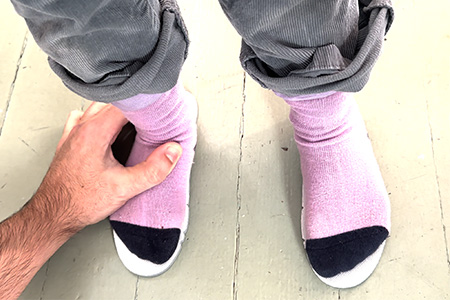
3. In this step, you need to make sure that your child is standing up straight and align the back of your child’s heels with the back of the insoles.
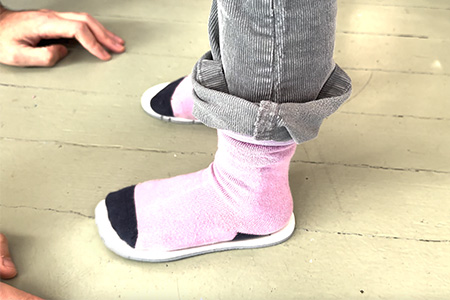
4. Check whether your child’s toes are matching the end of the insoles or not. The first picture shows a child standing up in the insoles and we can clearly notice that there is still growing room.

This second picture shows a child standing on the insoles and the toes match the end of the insoles, which means that it’s time to get new shoes:
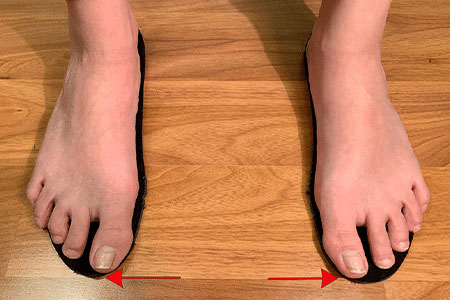
There should always be space a certain amount of space between your child’s toes and the end of the shoes. This is particularly important when you have a baby or a toddler as they tend to wiggle their toes as a way of exercising their feet. If there is not any space you will be constricting this toe movement.
How to Retrieve Your Child’s Exact Foot Length and Shape
Choosing the right shoe size for your child involves more than just selecting a shoe that isn’t too tight. The right fit supports healthy foot development and can prevent various issues, such as blisters, calluses, and even long-term foot deformities.
If you prefer to order your kids’ shoes online I suggest that you take advantage of a free virtual shoe fitting service I created that helps parents determine the child’s foot shape (narrow, medium, wide, extra wide feet) and instep height, and the shoe size they should order online.
How to Check for Growing Room Inside Your Kids’ Shoes – Watch Video!
Welcome to our channel! In this video, I will show you how to check if your kids’ shoes have enough growing room. You will be able to better visualize everything I described in the article.
Is it Harmful to Kids to Wear Shoes Too Big or Too Small?
Shoes that are too big can compromise your child’s stability and make your child more prone to falling. On the other hand, shoes that are too small can cramp your kids’ toes and make them rub or overlap against one another. That constant friction and rubbing between the toes and the shoes can lead to blisters. Shoes that are too small can also lead to hammer toes.
If you don’t believe me you can ask my aunt Silvia who developed a bunion from wearing ill-fitting shoes as a child. There was no history in her family of hammer toes, but she does remember that all of her shoes used to pinch her toes.
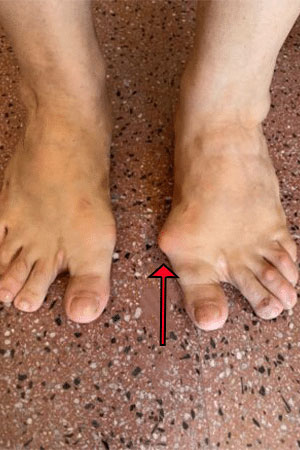
I understand how parents might be tempted to always provide their children with some extra growing room as children’s feet tend to grow so fast. However, believe me when I tell you that it’s not worth it to put your child at risk of developing a foot issue or foot condition just to allow your child to wear the shoes a little longer. The problems that wearing ill-fitting shoes can create far outweigh any savings on new footwear, particularly when their feet are still developing.
Is it Better to Buy Shoes Bigger or Smaller?
It is always better to buy bigger shoes rather than to buy smaller ones. However, please remember that shoes that are too big can compromise your child’s stability and have a negative impact on your child’s walking gait.
How Quickly Do Kids Grow Out of Shoes?
Children’s feet can grow rapidly, especially during growth spurts. If you leave the correct amount of growing room inside your kids’ shoes you can expect your child to outgrow the shoes anywhere between 3 1/2 to 6 months (depending on your child’s age). The rate of growth depends on the age of the child, so I break it down by age. These guidelines should be taken as an estimate since every child grows at a different rate.
➡️ Children between the ages of 1 to 3 should have their shoes replaced every 3 ½ to 4 months. Your child’s feet might grow ½ size to a whole size every 4 months.
➡️ Children between the ages of 4 to 6 should have their shoes replaced every 4 ½ to 5 months. Your child’s feet might grow ½ size to a whole size every 4 to 5 months.
➡️ Children between the ages of 7 to 10 should have their shoes replaced every 5 months. Your child’s feet might grow ½ size to a whole size every 5 to 6 months.
➡️ Children between the ages of 11 to 17 should have their shoes replaced every 5 ½ to 6 months. Your child’s feet might grow ½ size to a whole size every 6 months.
Shoe Recommendations From a Shoe Fitter
Selecting the right shoes for your child involves considering several factors, including their age, activity level, and any specific foot concerns they might have. I can provide you with specific shoe recommendations tailored to your child’s unique foot shape, so don’t hesitate to contact me via email or through the comments section below.

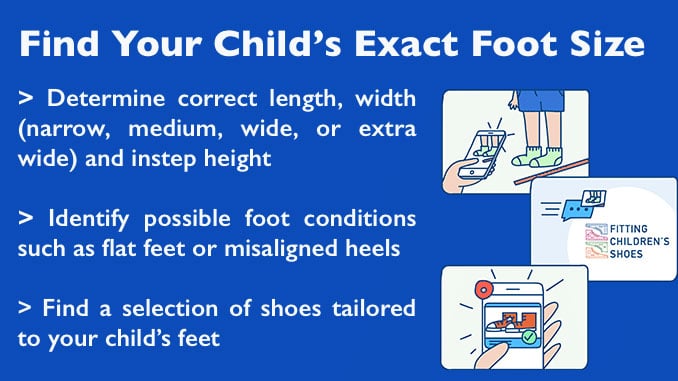
Not helpful at all. The first photo clearly shows the big toes are already going inwards and the insoles indicate the shoes are too narrow.
Hello Renata,
The big toes going inwards don’t really play a role in determining whether the child has growing room inside the shoes or not, it is important to make sure that the child is not curling his or her toes.
The image with the insoles is to visualize whether there is growing room in the front part of the shoes.
This article and video are very helpful in understanding what might be causing the toe walking for my grandson. I am excited to hear back from you on the proper sizing for his feet. I look forward to hearing what recommendations you have for shoes as well. Thank you for caring and sharing your knowledge to help children overcome to walking ❤️
Hello Linda,
I am happy to help and glad to hear that you find the website informative. I have received your email and will respond shortly.
Hiya, 8/6/22 I bought a pair of shoes from Clark’s for my daughter. (First shoes)
1 foot is 2.5 and 1 foot 3. The shoes are a 3F.
I had her feet measured and they said she is now a 3 and a 3.5.
Do I need to upgrade the shoes every half?
Hello Chloe,
That depends on whether the shoes that you got for your daughter fit short, long, or true to size. If the shoes fit long, then they still might fit your daughter’s feet.
I am assuming that you are contacting me from the UK, and that you got the shoes on June, not August. It has been two months and a half since you got the shoes, so your daughter might have grown a half a size.
You can use this free resource to confirm your daughter’s foot size: How to Measure Your Kids’ Foot – 2 Simple Steps to Determine Foot Length and Foot Width